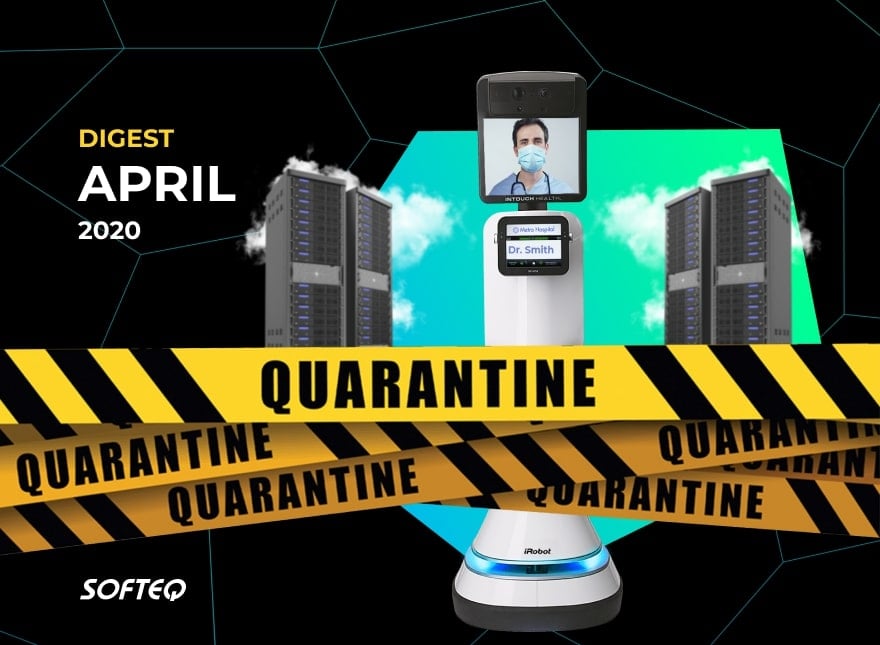In this issue of the Tech Digest: machine-washable sensors improve patient monitoring in and out of the hospital, IoT devices talk to each other underwater, and the technologies that are giving a much-needed boost to the Internet of Things market in 2020. All that and more in a 10-minute read.
How technology companies are surviving the quarantine, and what comes next
The COVID-19 pandemic and subsequent quarantine measures have sent the world’s economy into a tailspin. However, many entrepreneurs see the time of uncertainty as a business opportunity for the technology sector. The online education market is growing at a CAGR of 16.6%. The use of teleconferencing solutions like Zoom and Microsoft Teams has jumped 300%. Healthcare providers are using drones to deliver medical supplies and test samples to and from rural areas. In our new blog post, we discuss how technology companies could weather the coronavirus storm and where the technology sector is headed.
The pandemic is paving the way for next-gen telemedicine systems
The factors that prevented patients from seeing their GP via a video call before the pandemic included the limited availability of telemedicine solutions and doctors’ reluctance to upend the standard model for care delivery. Amid the COVID-19 crisis, telehealth visits have surged 50%. Does it mean we’re on the verge of the healthcare revolution? In 2020, remote patient monitoring is not limited to video interactions between physicians and patients. Instead, we should be talking about video interactions aided by smart devices like connected insulin pumps and AI-powered stethoscopes. Emerald, a smart device developed by MIT’s Computer Science and Artificial Intelligence Laboratory (CSAIL), is one of the early examples of such systems. The gadget can be installed at hospital wards or in a patient’s home. It transmits low-power wireless signals, which bounce off a human body, and captures the return signal via a receiving antenna. By analyzing the electromagnetic field changes, Emerald can measure patients’ heart rate, gait, and sleep patterns, and thus allows caregivers to track the progression of the coronavirus disease remotely. According to VentureBeat, Emerald has already been deployed in over 200 US hospitals. Another way to collect biometric data round the clock is to embed smart sensors into hospital gowns. Earlier this month, MIT researchers published an article describing their new machine-washable sensor strips, which can be woven into narrow channels in fabric. This way, the sensors come in direct contact with the skin and measure a person’s heart rate, body temperature, and movement.
The when, why, and how of Android customization
Google allows developers to create custom operating systems based on the Android source code, also known as the Android Open Source Project (AOSP). That’s how HTC and Xiaomi design unique user interfaces for their smartphones and inject Android into a variety of wearable devices and home appliances. If you’re looking to build your own OS on top of Android, you may be wondering whether your gadget will get access to the Google Play Store and automatically install Android updates. These are just a few of the questions highlighted in the new article by Technology.org.
The Internet of Underwater Things: scientists propose a new technology to enable communication between IoT devices on the seabed
As IoT continues to invade the logistics, travel, and oil and gas industries, companies begin to wonder whether smart devices could function below the ocean surface. The radio signals, which give voice to “terrestrial” IoT solutions, die rapidly in water. Acoustic communication works just fine, but it lacks speed and can be overheard by cybercriminals. Scientists from King Abdullah University of Science and Technology (KAUST), Saudi Arabia, managed to establish underwater wireless communication between an energy harvesting sensor and receiver. For this, the research group used simultaneous lightwave information and power transfer (SLIPT) technology. Besides data exchange, SLIPT charges IoT devices in locations where continuous powering is either costly or altogether not possible. Network World sheds light on the new technology and its potential applications in business.
From smart stores to connected hospitals: how Bluetooth Location Services improve indoor navigation and item finding
In 2020, 4.6 billion Bluetooth-enabled devices will be shipped globally. One hundred eighty-six million of these devices will use Bluetooth Location Services. The technology helps establish communication between two Bluetooth-powered gadgets and estimate how close they are to each other. Discover how businesses leverage Bluetooth Location Services to engage customers at stores, help employees navigate around large office buildings and warehousing facilities, and improve construction site safety.
Humans are one step closer to controlling machines with our minds. But are we really?
Brain-computer interfaces (BCIs), which help people control prosthetic devices using their thoughts, have been around for decades. They cost a fortune and need to be recalibrated continuously to keep up with the fluctuating activity of a human brain. In other words, the BCIs of today are nothing like the mind-reading devices we’ve all seen in sci-fi movies. But there’s an improvement on the horizon. Researchers from Carnegie Mellon and the University of Pittsburgh created an algorithm that levels out neural activity and stabilizes BCI performance. Tristan Greene of The Next Web provides a brief overview of their research and raises an interesting question: just how close are we to telepathically communicating with apps and devices around us?
IoT in 2020: where is the technology heading?
The bold predictions analysts were making about the Internet of Things in late 2019 will most likely remain unfulfilled. Today, it’s impossible to discuss IoT trends outside of the quarantine context. Welcome to the new reality where drones make long-range deliveries, governments create virtual copies of entire cities to predict how the coronavirus will spread, and telehealth evolves beyond video interactions. Read our latest article to learn how the global lockdown is affecting the Internet of Things.

